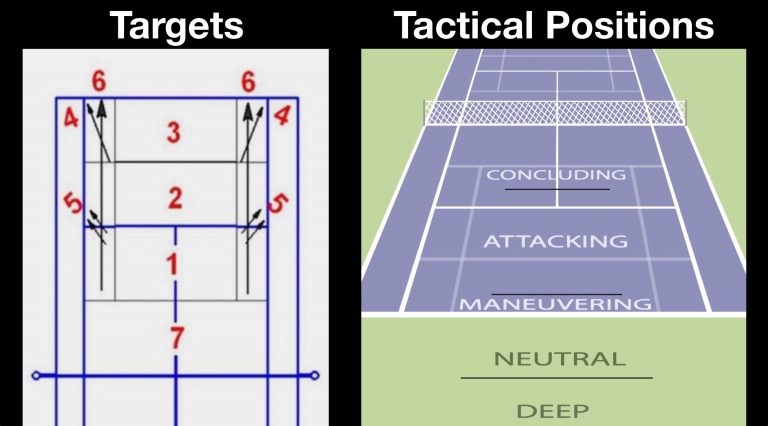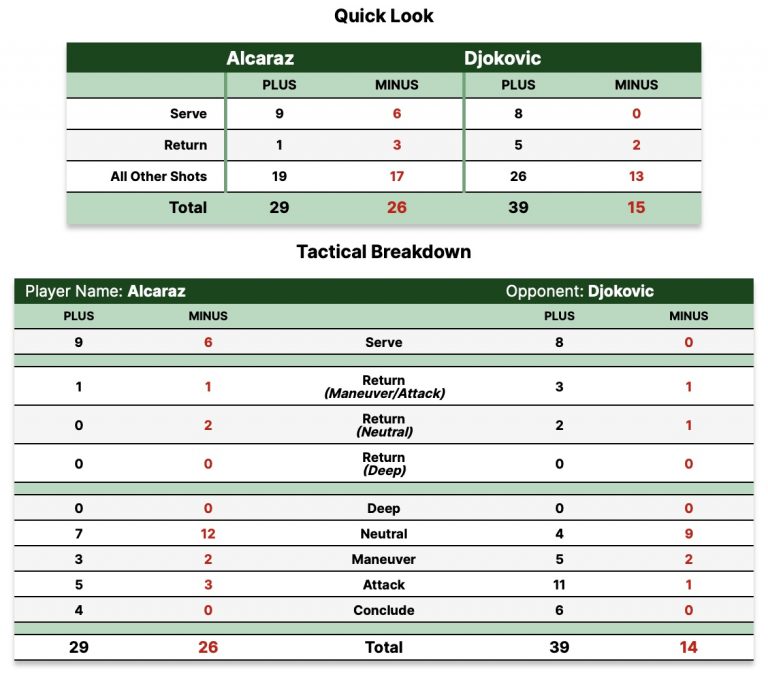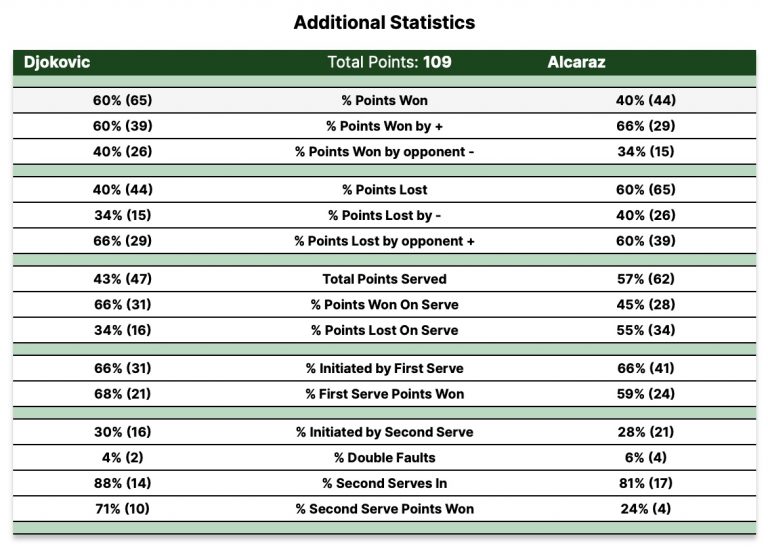
The Spaniard and The Serb: The Analytics of the 2023 Wimbledon Final: PART 1
The spectacle of the 2023 Wimbledon Men’s Final filled Center Court with 4 hours and 42 minutes of drama. With momentum shifting and surging, a historically great 36 year old champion fell to a remarkable young Spaniard, barely past his teenage years.
In just his fourth ATP grass court tournament, Carlos Alcaraz stopped another relentless Djokovic quest for a calendar year grand slam and denied the Serb his 24th major title. Alcaraz also became the third-youngest men’s Wimbledon champion in the Open era at 20 years and 72 days old. Boris Becker won the title at 17 and again at 18 years old, and Bjorn Borg won his first Wimbledon at 20 years and 27 days old.
The culmination of this Wimbledon fortnight was a tale of 2 different matches. From the 2 sets won decisively by Djokovic to the 3 closely contested sets won by Alcaraz, our 7 Shot Tennis statistical data reveals significant contrast in key performance areas.
This match began like their most recent match ended. Like their highly anticipated French Open semifinal just weeks prior, the first set of the Wimbledon Final was a one-sided affair. The first set concluded with the same score as the final 2 sets in their match at Roland Garros; 6-1 to Djokovic.
After losing the second and third sets, Djokovic showed his resolve by storming back and winning the fourth set in convincing fashion; 6-3.
For those unfamiliar, the 7 Shot Tennis system of recording point-ending shots utilizes an intuitive Plus – Minus system. Pluses consist of aces, winners & shots that result in a forced error by the opponent, while minuses are unforced errors & double faults. For every plus or minus, the stroke used, tactical position and target area are also recorded. This enables us to generate data that consists of where all point-ending shots are hit from and where they are hit to.

Our 7 Shot Tennis tactical breakdown reveals the key ingredients of Novak’s dominance in both the first and fourth sets.

In the 2 sets Djokovic won, he had 39 Pluses and 15 Minuses overall, while Alcaraz had 29 Pluses and 26 Minuses in total.
The Serbian served and returned more effectively than the Spaniard in the first and fourth sets. In total during these 2 sets, Djokovic had 8 Pluses on Serve and 0 Minuses, while Alcaraz had 9 Pluses and 6 Minuses on his own Serve. When you combine that with Djokovic’s 5 Pluses to 2 Minuses on his Return of Serve, and Alcaraz’s Return performance resulting in 1 Plus and 3 Minuses, these 2 key areas set the stage for an uphill battle for Alcaraz during these 2 sets.
During these 2 sets, Djokovic’s historically great return of serve was on full display, repeatedly hitting returns from the neutral area into Target Area 3. During the first and fourth sets, Alcaraz lost more points on his own serve than he won. Points played on second serve were particularly pivotal in these 2 sets, with Djokovic coming out way ahead both on his own second serve points and on points when Alcaraz hit a second serve. Alcaraz won only 24% of his second serve points, while Djokovic won a staggering 71% of his second serve points. To put that into perspective, the ATP Tour shows that a historically great servers Nick Kyrgios and Ivo Karlovic won 53% of their second serve points for their respective careers, while John Isner won 55%.

In the Neutral area, both players during these 2 sets were behind in their Plus / Minus differential. Djokovic had 4 pluses and 9 minuses, while Alcaraz had 7 pluses and 12 minuses. With Alcaraz’s numbers higher in both areas, this perhaps illustrates some nerves in the first set, a perhaps questionable belief in his ability to beat Djokovic on this stage, and a propensity to get a little impatient at times over the course of these 2 sets.
“Before this match, I thought, ‘I can’t beat Novak.’ But after this epic match, I’ll think different about Novak. In other Grand Slams, I will remember this moment,” Alcaraz said in a post match interview.
In the 2 sets that went to Djokovic, he was able to get on offense frequently and was very successful doing so. Often during neutral rallies, Djokovic’s shot placement into the singles alleys and target area 3 put Alcaraz on defense. His accuracy and a frequent strategy to hit behind the quick moving Spaniard gave him many opportunities to move up inside the baseline to control points.
The 23 time grand slam champion had a very positive combined Plus / Minus Differential with 22 Pluses to 3 Minuses in the Maneuvering, Attacking and Concluding tactical positions.
Alcaraz also had a positive Plus / Minus Differential in offensive positions in these 2 sets, but to a lesser degree both with frequency and success rate compared to Djokovic’s performance. In total, Alcaraz finished these 2 sets with 12 Pluses and 5 Minuses in the Maneuvering, Attacking and Concluding areas.
Part 2 of this article series will take a look at how Alcaraz evaded a two set to none deficit, won the third set to take control of the match and clinched the title in a thrilling fifth set.
The analytics for the 3 sets Alcaraz won reveal key performance areas that illustrate how he was able to dethrone the reigning Wimbledon champion. Despite making some questionable tactical decisions that were often protected by phenomenal shot making, the young Spaniard was able to significantly elevate the level of play on his serve and frequently found ways to put himself into successful offensive positions.
Watch the video below to view a short edit of the 2 sets Djokovic won.
